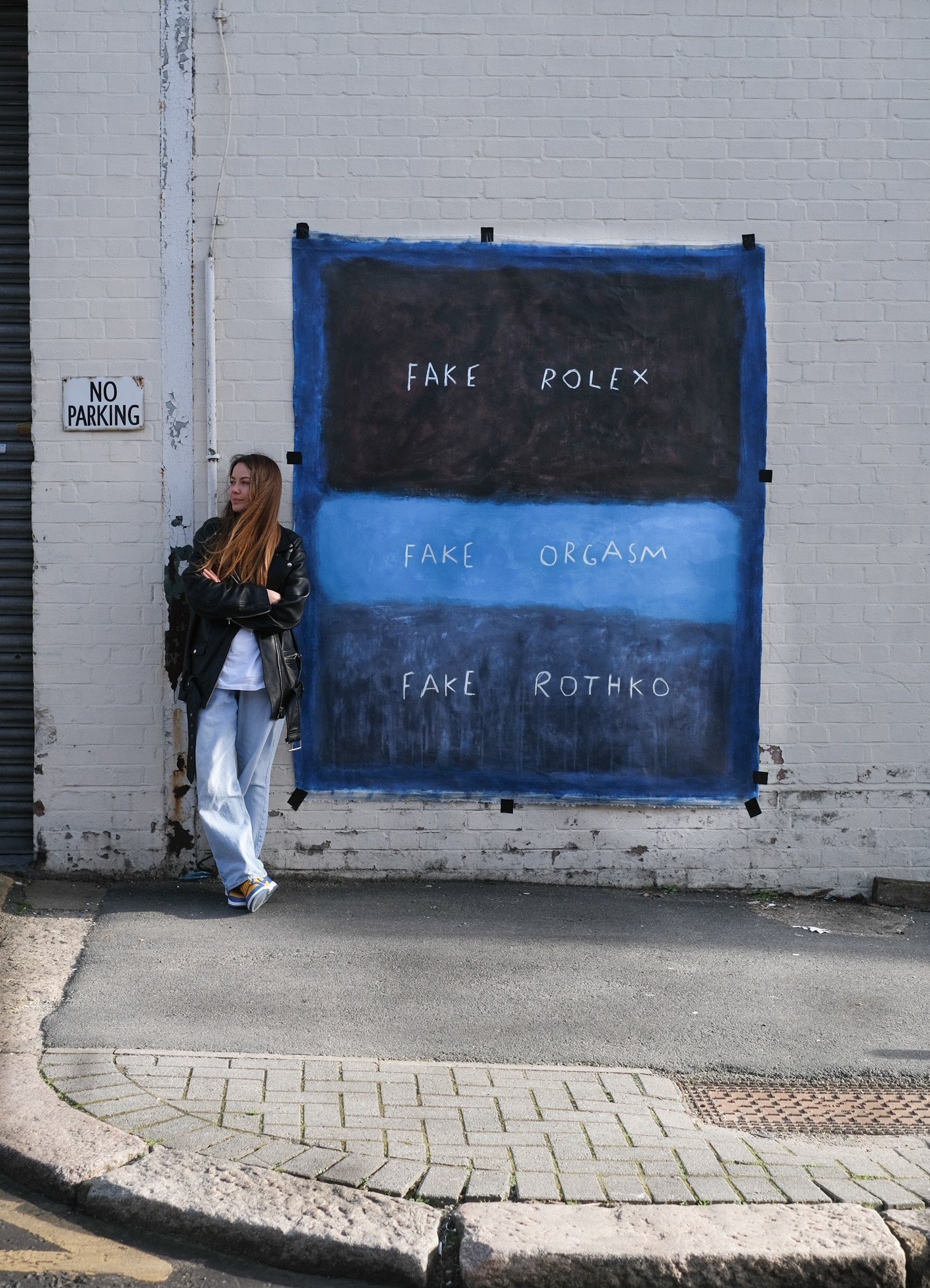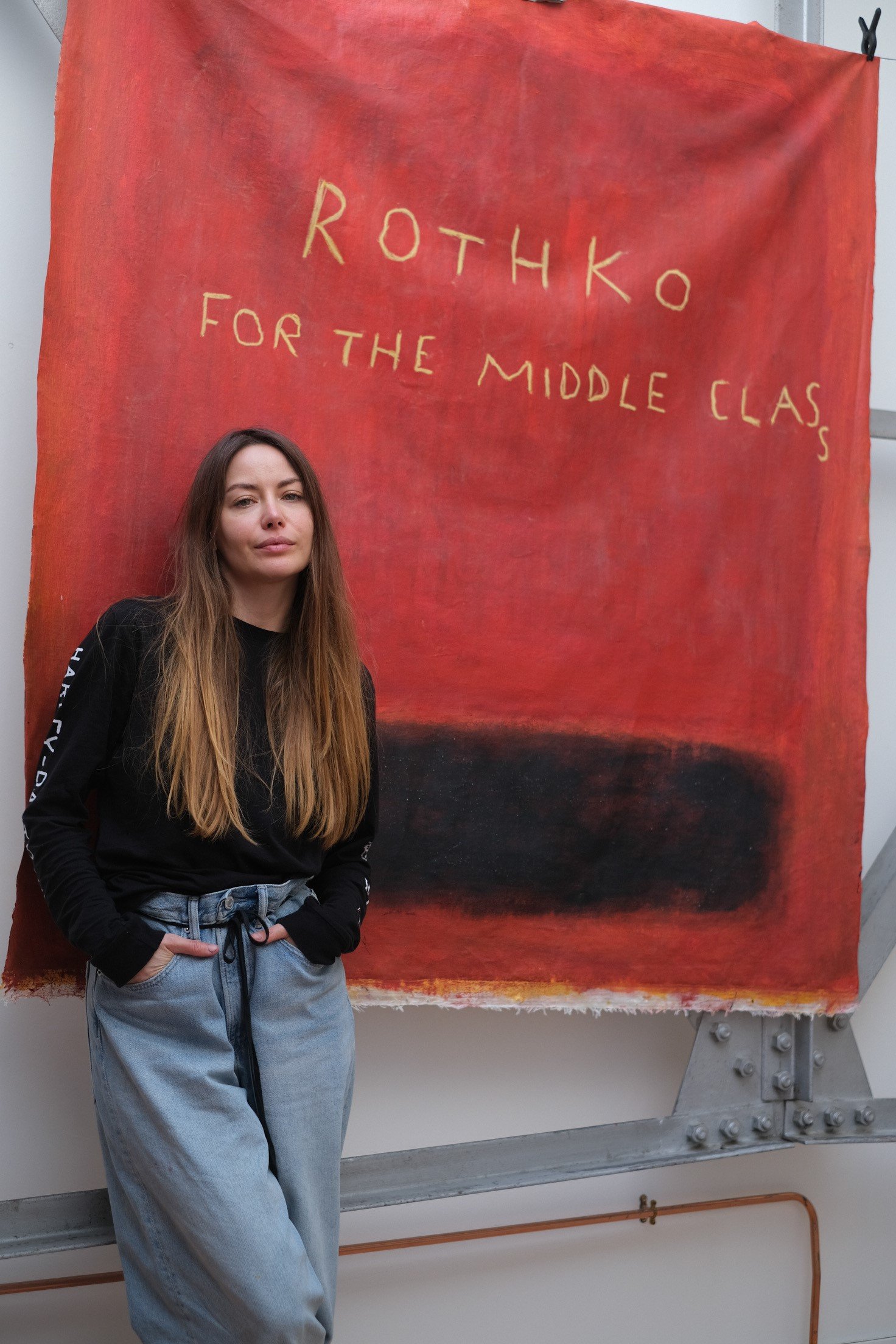Alexa Agienko
Alexa Agienko is an emerging Ukrainian artist born in Slavutych who splits her working time between Kyiv and London. Leaving her childhood inclination towards painting, she transitioned to photography and media art, ultimately returning to her painting roots years later.
With her series Fake Rothko, the artist troubles the notions of authorship, originality, and the ethos of the art market.
Alexa Agienko.
Featuring inscribed reproductions of Rothko’s work, this series attracted the attention of the current art scene. The copies read “Fucking fake Rothko”, “Looks like Rothko, but it’s not”, “Fake Rolex, fake orgasm, fake Rothko”, “Rothko for the middle class”, or “Fake Rothko by fake artist”. These works, usually shared by the artist on Instagram, have also caught the eye of its users, who have expressed their opinion in razor-sharp media comments. They show anxiety concerning the illicit copy of Rothko’s work while blaming the pieces –and the artist– for their lack of creativity and originality. Behind a photograph of her work Rust and Blue, a guy states that he is an artist and what keeps him going “is the hope that one day the art history is going to assign me a minuscule spot on its chart as an original artist… because if I weren’t creative, I wouldn’t be an artist!”.
Aside from confusing such concepts as originality and creativity, the quest for realness on Instagram seems to be quite ironic, to say the least, as this kind of media is the quintessence of Baudrillard’s “desert of the real”, which describes the space where every reference point has been substituted by its copy, its simulacra. [1] So, in some ways, these remarks reinforce the work by completing it, acknowledging that Agienko’s art seeks to problematise: the informing principles of the art market.
Principles that seem outdated attend to Rosalind Krauss’ arguments in ‘The Originality of the Avant-garde and other modernist myths’ (1985), where she argues how even the Avant-garde formed itself on a sense of repetition. [2] Consequently, from Dada on, artists such as Jackson Pollock, Sherrie Levine or, recently, CB Hoyo have increasingly used plagiarism, reproduction, and appropriation as a creative principles.
Rothko’s work, which conveys secrecy, myth, and religion through simple compositions based on colour field painting, stands as an intuitive gesture, the inner expression of an individual, autonomous self, painting out of radical freedom. His body of work granted him a leading position within Abstract Expressionism, whose artists were considered the epitome of the sovereign, stable, independent individual. This discursive structure, substantiated by the Western philosophical tradition and further instrumentalised by the Modern ethos of self-origination, reinforced a cult around Abstract Expressionist artists that still translates into smashing records at auctions.
Considered to be America's first modern art movement, the model of the artist/superstar – macho and self-absorbed – resonated with Henry Clay’s idea of the self-made man, which, although primarily dismissed as a myth, remains at the foundation of the United States culture as well as the capitalist ideology.
Alexa Agienko, Red & Black (Rothko for the middle class), 2023.
On Instagram, and beneath a photograph of Agienko’s Red & Black (Rothko for the middle class) (2023), someone seems quite annoyed, stating that “Rothko is already for the middle class; he gave his late works to museums”. And while that might be true, this shouldn’t be the matter of contention here, as it is ultimately the contemporary art market scene at the stack in Agienko’s Fake Rothko series. The decision to copy Rothko is not accidental but intended to portray a dynamic that subsumes artworks to their exchange value through the reification of money, which has now become the universal equivalent.
Agienko’s Abstract Expressionist reproductions are no longer autonomous oeuvre but work embedded in the material conditions of their time, further conveying an affective dimension encapsulated in aesthetics and related to how the see-saw process involves the individual’s embodied subjective experiences. That is how works like Red & Black (Rothko for the middle class) speak to the growing precarity within the art world –outside the capitalist art establishment– but also to the precarity, and precariousness, of our social lives –outside the capitalist establishment–. This affective dimension attempts to act as a visceral prompt while articulating our body’s capacities to act.
Therefore, Agienko’s work is neither a copy nor an imitation but an intervention into the dynamics of an art world blanketed by money and articulated by discursive practices that sustain and enhance the art market’s bubble.
Alexa Agienko.
Mark Fisher’s ideas on Capitalist Realism might aid in understanding how the discursive practices sustain and enhance this bubble while simultaneously structuring the public’s taste and the artists’ work. [3] In an era when imagining a world extraneous to the capitalist framework becomes impossible, artists assume that art might only exist within a hate-love relationship with the market. The creators’ feeling that this is a necessary tension, even a condition of possibility, as trading principles dictate the artistic paradigm of success, precludes any potential for other kinds of art. Artistic creation is progressively narrowed to satisfying the demands of investors, complying with the guidelines of production grants from public institutions –which results in a neutralised political art at best or in propaganda at worst– and seeking the validation of art patrons.
The Fake Rothko series might not be a stellar intervention, but it works while it troubles the bubble's surface tension. Always about to explode and nonetheless designed to resist, it gobbles up the otherness to assimilate and neutralise that which is distinct and inflammatory. This is further epitomised by her work exhibited for the first time in the United States at the newly opened SAV Gallery Los Angeles, where she is part of the group show Iridescence. The decision can be interpreted as a strategy tailored to stressing the market dynamics of co-opting difference to deactivate it or just as succumbing to the violent dynamics of capitalism.
Alexa Agienko.
Either way, the fact that the Fake Rothko series are now vested by market validation, framing them with those narratives they pledged to defeat, reinforces the tension they seek to articulate. That there is no longer a form to be conceived outside the market’s circuits and validation – problematising the art market compromises the status of the work as art, but detaching from it nullifies the work. So, everyone can have a piece of the cake so long as they agree to sit at the table.
Bibliography:
Baudrillard, Jean, and Sheila Faria Glaser. Simulacra and simulation. The University of Michigan Press, 2020.
Krauss, Rosalind E. The originality of the avant-garde and other modernist myths. MIT Press, 2010.
Fisher, Mark. Capitalist realism: Is there no alternative? Alresford: Zer0 Books, 2022.
Laia M. Llobera
Contributing Writer, MADE IN BED







